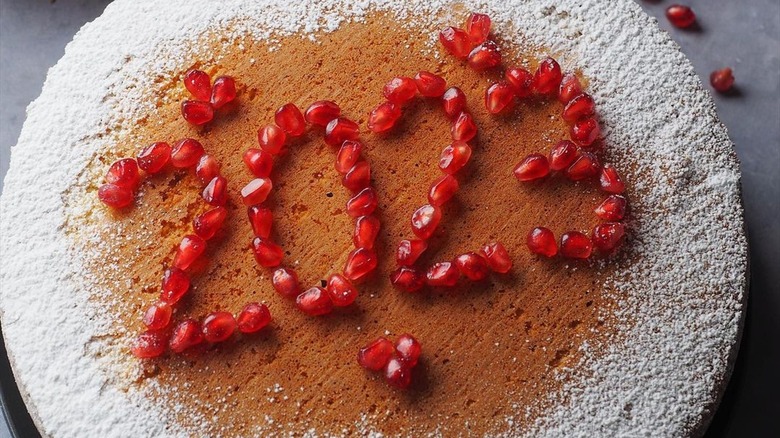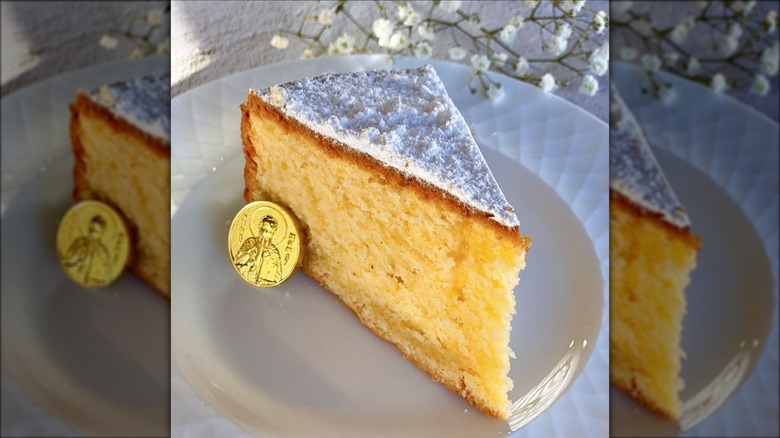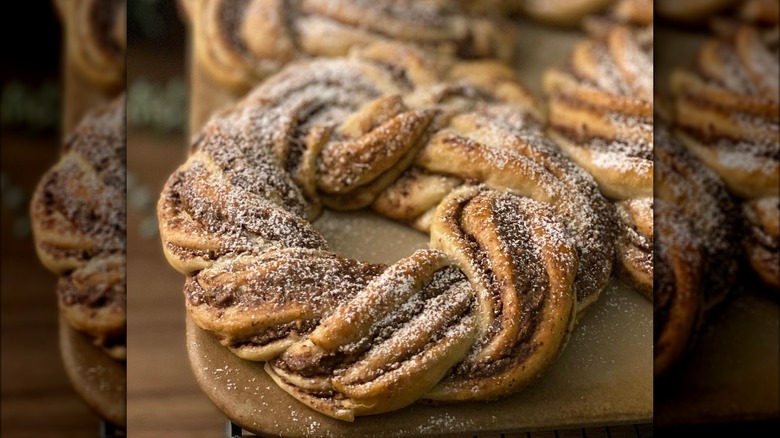Vasilopita: The Cake That's Considered Good Luck On New Year's
Various cultures have traditions involving some type of prize hidden inside a cake -– in Ireland, charms baked into barmbrack help foretell the eater's future on Halloween, while king cakes, which are eaten at Epiphany or Mardi Gras, may contain tiny figurines of babies or kings. In Greece, the cake with a surprise inside is called vasilopita and it features prominently in New Year's celebrations. Vasilopita, which can either be a true cake or a sweet bread, is sliced just after the clock strikes twelve and the calendar rolls over into a new year.
According to custom, the head of the table first makes the sign of the cross over the cake and then cuts each slice while calling out the name of the intended recipient. The first piece is for Jesus, the second for the Virgin Mary, and the third for the house. By the fourth slice, the cake is finally distributed to the people in attendance, with the first one going to the household head and subsequent ones generally distributed on the basis of age. In some families, even the members who aren't present get a piece, as do pets, although we can't say for sure what happens to any cake that goes uneaten. As to where the prize comes in, this is typically a coin, either a foil-wrapped one or one sold specially for this purpose. Receiving the coin is thought to bring good luck and may come with an additional, more tangible, gift as well.
History of vasilopita
The word "vasilopita" is a Greek portmanteau of two words. One of these is pita, which in Greece does not necessarily mean the type of flatbread we're familiar with in the U.S., but instead may refer to pastries such as cheesy tiropita. The first part of the portmanteau, however, is derived from the name Vassilis and refers to the man we know in English as St. Basil of Caesarea or St. Basil the Great. His feast day is January 1, which explains the vasilopita-New Year's connection, but yes, the good saint himself has something to do with the whole coin-in-the-cake tradition, too.
St. Basil was a 4th-century bishop in Caesarea Mazaca, which today is the Turkish city of Kayseri. At one point, the city was under siege, and for some reason, the bishop was tasked with hitting up the citizenry for donations to go toward a payoff. The siege got called off so the payoff wasn't needed, but poor old Basil had failed to keep records of who gave what. According to legend, he just baked cakes, divvied up the loot between them, and gave these cakes out as thank-you gifts to the donors. Miraculously, each one got back the exact same item they'd donated. A simpler version of the story, though, just involves Basil baking coins into cakes to give to the poor. While the cakes were meant to disguise the coins so as to preserve the recipients' dignity, they also got a tasty lagniappe.
How vasilopita is made
Vasilopita, if it's the cakey kind, is your pretty standard kind of yellow cake made from butter, eggs, flour, sugar, and frequently crushed almonds to add some texture. It may be flavored with vanilla and orange juice or zest, while additional ingredients such as yogurt or brandy might also be added. The cake is first baked and then the coin, which is usually gold or silver in color, is inserted through a little slit made on the bottom of the cake. As for the frosting, this may be a simple glaze made of powdered sugar and water or perhaps just a dusting of the sugar on its own. Decorations, of course, may be as simple or elaborate as you like but are often in keeping with a New Year's theme.
The sweet bread vasilopita, or vasilopita tsoureki, is somewhat more time-consuming as it is a yeast bread and thus needs to be kneaded and left to rise. It might also be braided before being formed into a round shape that can fit into a cake pan. The flavorings here also tend to include vanilla and orange, but other spices such as the piney-tasting mastic and nutty mahleb may also be used. This sweet bread, like the cake, could be sugar-glazed or dusted, although its more uneven surface might tend to limit the decorating possibilities to some extent.
Vasilopita variations
While the vanilla-orange cake and sweet bread versions of vasilopita may be the most common varieties, there are a number of different variants including several savory ones. One of these is made with cheese, while another, which comes from Thessaly, may include chicken, onions, and tomatoes and flavored with cinnamon. In Macedonia, a Balkan region that includes the northern part of Greece, vasilopitas might be made with ground meat or smoked sausage and leeks and possibly even lemongrass and raisins. Sweet and savory vasilopitas also exist, such as a sweet bread flavored with allspice, cinnamon, cloves, nutmeg, and Romano cheese.
It is also not just possible but permissible to play around with the ingredients of sweet vasilopitas. Cakes may be made with dried fruits such as apricots and figs, or they could include chocolate chips. Some vasilopitas are flavored with honey and tahini -– shades of the dreaded dessert hummus! –- but chickpea-free sesame paste actually adds a nutty flavor that is not at all out of place in a cake. With the bready type of vasilopita, some cooks like to tweak the texture a bit and turn it into something lighter and more brioche-like.
Where to buy vasilopita
It probably goes without saying that vasilopita is fairly easy to come by in Greece in the run-up to New Year's Day and even throughout the following month since the cake or bread may feature at post-holiday celebrations in offices, churches, and other organizations. (Can't ever have too much luck going into a new year, after all.) This tradition also extends to some U.S.-based Greek organizations, as well, among these the Hellenic Bar Association of Illinois and the Greek Orthodox Metropolis of Chicago (the latter's 2023 event was their 62nd).
Your best bet for acquiring a vasilopita in the U.S., assuming you don't want to DIY it, is to inquire at a Greek bakery such as the Victory Sweet Shop in Queens, New York, or Pan Hellenic Pastries in Chicago. You might also find vasilopitas sold by church-affiliated organizations such as the St. Irene Philoptochos Society in New Jersey which sources its cakes from the Agia Skepi (Holy Protection) Monastery in Pennsylvania. If you're not in close proximity to any Greek-run businesses, however, you can always order your vasilopita online. Among the online storefronts offering this item are the Pennsylvania-based Greek grocer Athos Foods and the New Jersey bakery Liberty Greek Pastries.




